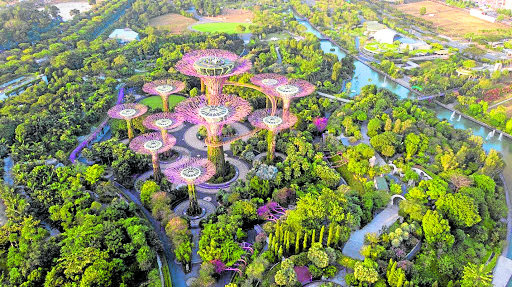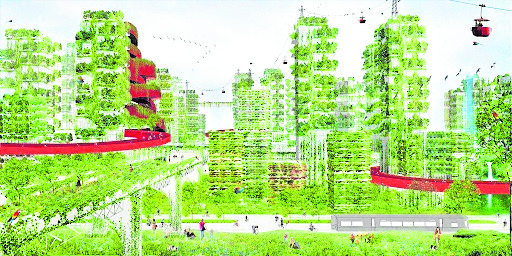Urban transformations: ‘Re-naturing’ the city
(First of a series)
The now familiar night shot of Metro Manila taken from the International Space Station shows the beauty of the city’s sparkling lights floating in the backdrop of darkness, mirroring the stars and space from where the photo was taken.
At the same time, however, it also underscores a reality of urban development—the strong dichotomy between city and countryside or between the built and the natural, and the hard line that seems to separate the two.
Cities, from the most fundamental economic perspective, are the concentrations of surplus. They are where labor, markets, goods, people, knowledge and wealth accumulate and are exchanged and reproduced for further accumulation. They are the engines of growth, generating 80 percent of global economic output.
What is less emphasized is how the economic engine of cities rely on its hinterlands for food, water, energy and resources needed to support urban activity. Similarly, the byproduct of cities, which come in the form of waste and pollution, are returned to nature and the hinterlands in a linear relationship of extraction, production, consumption and waste.
The comfort and overall prosperity generated by cities have increasingly detached modern society from nature. Urban dwellers are not immediately aware of the impacts of our lifestyle on our environment such as where our waste goes or where our food comes from.
We have disassociated ourselves from the land, cutting off the connections between man and nature. We are not aware of the effort it takes to bring food, water and energy to our homes or how wastes are processed after we discharge them because of the invisibility of the process to us.
The crises of pandemics, climate change and of resource, food and water scarcity are ultimately borne out of the disengagement of society from nature. More fundamentally, expelling nature from our daily urban life creates a deficit in our innate biophilic nature. As human beings, we need to connect to the outdoors, with other living organisms, with the sun, fresh air, the soil and in so doing, connect with other people as well.
Should nature and cities be mutually exclusive, opposing forces that are inevitably and perpetually bound to a zero-sum arrangement? An antinomy of two essential forces in opposition?
How much green?
If we are to quantify the economic benefit from nature, we derive an estimated at $125 trillion in ecological service provision per year, an amount that is more than twice the global GDP (Constanza et al., 2014). These benefits are supplied by nature that might otherwise be provided through expensive technology and built infrastructure such as absorbing pollution, treating waste, etc.
And yet, despite the social, economic and survival necessity of the natural environment, we have continuously reduced its presence in urban areas where 60 percent of humanity are currently living. This is most pronounced in Metro Manila which has only 5 sqm of green open space per inhabitant, compared to the minimum 9 sqm recommended by the World Health Organization. It lags behind other cities in Asia and the rest of the world in green open space provision, according to a 2011 research by the Economist Intelligence Unit which studied 120 cities worldwide.
How did we come to this level of deficiency? A large part of it is because urban spatial development has largely followed the rationality of free market economics with little emphasis on (or at the expense of) ecological rationality and human well-being. The Philippines, typical of developing countries, is subject to increased environmental pressures caused by urban sprawl and real estate speculation which generate more environmental as well as social and economic exclusion.
Reconnecting man and nature
The search for the ideal, wherein nature is brought back into cities, has been the holy grail of urban planners throughout history. From greenbelt cities, green wedges, vertical gardens to biomimetic cities, nature-based urbanism and the Ecopolis, countless concepts from architects and planners have sought the ideal environment where nature is reinserted into artificial realm.
Re-naturing cities can take many forms and scales but in the simplest sense, it is creating space for habitats where species can thrive allowing them to perform natural functions such as cleaning the air and water, processing waste, producing food, absorbing carbon dioxide, conserving the soil and reestablishing biodiversity.
Re-naturing can involve ecomimicry, which emulates ecosystems and ecological communities as a basis for designing artificial systems like factories, cities, farms and settlements. It can also involve eco-engineering, combining systems ecology with engineering design to arrive at solutions that require less materiality and which aims to achieve harmony between materials and structure by imitating nature’s efficient processes.
Inviting nature back into cities requires making room for it. It means connecting outdoor areas to create continuous green networks. It means integrating it in our buildings and creating more outdoor space for vegetation as much as we can—balconies, roofs, walls. It also means envisioning indoor spaces with bio-habitats. It means redesigning infrastructure to replicate processes that occur in nature.
In order to ensure that such re-naturing occurs on a scale sufficient to reconnect all urban communities with nature, designs must provide multifunctionality in terms of ecosystem service provision—for instance, an urban farm that simultaneously produces food, builds biodiversity, creates a cooler micro climate and promotes social interaction.
Ultimately, urban re-naturing is about reconciling society with nature. Any sustainability effort will fall short without this goal in mind. In fact, cities should aim beyond sustainability and work towards regeneration.
As environmental expert Herbert Girardet said, “There is much less to sustain today than when the term was first used in the ’80s. We have to start thinking in terms of regenerative development. This means working towards giving back to nature as much we take.”
Joel Luna is founder and principal of JLPD, a masterplanning and development consultancy practice, Jlpdstudio.com



